John T. Lindsay, Ph. D., Peter F. Schoch,
Jim Conley, and Jarvis Franzblau
I. Introduction
In addition to controlling pests and eliminating harmful bacteria, irradiation has also been shown to extend the storage life of many foods.1,2,3 This effect makes irradiation particularly useful for fruits which are commonly infested and also require extended shelf-life in order to reach consumer markets in good quality. Although irradiation is often clearly a superior technology, there are constraints that restrict its use. Primarily among these are: 1) lack of regulatory approvals, 2) labeling issues, 3) lack of consumer information and understanding, and 4) the wide dissemination of false and incorrect information regarding irradiation .4,5,6 For example, in Japan (which as of 1986, irradiates over 10,000 pounds of potatoes annually) the average consumer is against food irradiation with Co-60 because of the belief that Co-60 is a waste product of nuclear reactors rather than a product made intentionally by the placement of Co-59 in a neutron field. Misinformation is the largest obstacle to the use of food irradiation in a time when the world needs to make more efficient use of its food resources. In reality, food irradiation is one of the most studied food treatment technologies to date. Irradiated food does not become radioactive. At the radiation energy levels used in food processing; only chemical changes are possible, not nuclear changes that would make the food itself radioactive. In addition, these chemical changes are primarily a function of the irradiation energy and can be minimized by using lower energies. Over 35 years of research suggest that the chemical by-products of radiation (“radiolytic products”) are mostly the same as the by-products of conventional cooking or other preservation methods. Animal feeding studies show no toxic, teratogenic or mutagenic effects from irradiated foods. In addition, irradiation leaves no chemical residues in food.7, 8
 Lexatronics, LLC is a Michigan based company that has a patent pending for the use of low energy x-rays for the irradiation of foodstuffs. Rayfresh Foods, Inc. holds the exclusive rights to market the Rainbow Process. Our process uses a combination of low energy x-rays, a proprietary design x-ray generator, custom filters, and unique design parameters. In this case, low energy is defined as an x-ray energy spectrum for which the maximum energy is 250 kVp or less. The actual maximum energy used is dependent upon the product being irradiated, the geometry used, and the level of penetration that is necessary. Penetration is a function of the irradiation energy and decreases with decreasing energy.
Lexatronics, LLC is a Michigan based company that has a patent pending for the use of low energy x-rays for the irradiation of foodstuffs. Rayfresh Foods, Inc. holds the exclusive rights to market the Rainbow Process. Our process uses a combination of low energy x-rays, a proprietary design x-ray generator, custom filters, and unique design parameters. In this case, low energy is defined as an x-ray energy spectrum for which the maximum energy is 250 kVp or less. The actual maximum energy used is dependent upon the product being irradiated, the geometry used, and the level of penetration that is necessary. Penetration is a function of the irradiation energy and decreases with decreasing energy.
Our specialized process allows a food processor to install one of our machines in their own plant and irradiate foodstuffs in-line with their other processes. For example, our machines can be placed in the current product line as the last step prior to packaging. Our approach provides for the custom design of the machine for very specific products, product shapes, and safety. We have a second generation machine (Rainbow II) built and currently in use in Wixom, Michigan.
The Rainbow Process can be used to treat a variety of foods ranging from red meats and poultry to fruits, vegetables and eggs, to fruit juices or any of the other approved items to destroy food borne pathogens and extend shelf-life. Our process is also ideal for treating ready-to-eat items such as lunchmeats or deli foods to eliminate Listeria.
We have used our process to successfully irradiate:
1. Several juices including: orange juice, apple juice, apple cider, grape juice, and grapefruit juice;
2. Several meat products including: ground beef, ground sausage, whole sausages, ready to eat meats, and hotdogs;
3. Several chopped vegetables including: white onions, green onions, lettuce, celery, green peppers, and mushrooms;
4. Several whole vegetables including: onions, mushrooms, cherry tomatoes, and nuts (almonds); and
5. Several fruits including: cherries, blueberries, chopped cantaloupe, green grapes, and raspberries.
In all cases we were able to irradiate the product without adverse effects and increased shelf-life significantly over the non-irradiated product in nearly all products.
We have been able to
1. Reduce and/or eliminate pathogens such as E-coli.
2. Extend shelf life on fresh squeezed orange juice from 5 days to over 30 days,
3. Extend shelf life on fruits and vegetables,
4. Stop fermentation in items such as apple cider,
5. Kill molds and yeasts on fruits and vegetables, and
6. Treat contaminated foods so they are safe for consumption.
The extension of refrigerated shelf-life obtained in experiments to date was as follows:
1. California sweet cherries—3-4 weeks,
2. Blueberries—4-6 weeks,
3. Fresh apple slices*—40 days,
4. Asparagus spears—3 weeks,
5. Fresh squeeze orange juice—60 days,
6. Chopped mixed salad greens*—4 weeks,
7. Chicken breasts—2 weeks,
8. Strawberries—3 weeks, and
9. Apple cider—3 weeks.
*Product irradiated in sealed packaging from producer.
These were just our initial tests and we feel we can improve our results by further testing to find the optimum process parameters.
The following photographs show some examples of our results. You can plainly see differences between the irradiated product and the non-irradiated product after the specified time. Clearly the Rainbow Process can be used to extend the shelf-life of a multitude of food products.
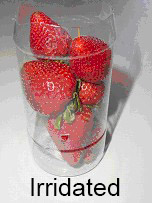
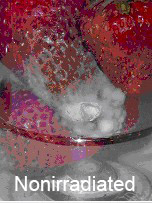


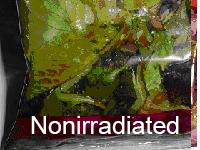
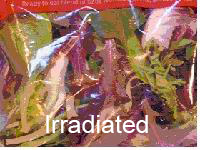
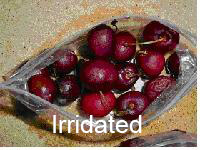
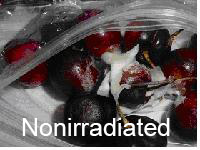
We differ from our competitors in three very important ways:
First, our design allows for the safe and easy use in presently existing food processing plants thereby eliminating the expense of transportation to and from central facilities.
Second, our process is designed to work on small packages or small amounts, which maximizes uniform dosing, thereby eliminating the burning and off-taste often associated with irradiated foods.
Third, our process is inherently safe because of its ability to be turned off at the end of the day and it does not require extensive shielding such as that necessary for high energy x-rays or Gamma sources such as Co-60.
We are currently the only company that has been able to successfully irradiate fresh orange juice and fresh grapefruit juice without changing the color or taste. This process is able to provide fresh squeezed taste with a refrigerated shelf life of at least 30 days.
Our processed juice was evaluated by food scientists at the University of Florida Extension Service and absolutely no difference in taste could be detected between the treated juice and the control sample. Based on our experience with our prototype machines, we believe that our design for a commercial juice machine will deliver 100 gallons per minute of properly irradiated juice.
In conclusion, the Rainbow Process can provide increased food safety by eliminating pathogens and increase the total usable fraction of the existing food resources by extending shelf-life. With proper sizing and design, we can customize the machine to fit the needs from the small food processor to the largest for pennies per pound without the expense of several million dollars per machine. Our machines are safe and can be easily incorporated in-line with almost any food process line with minimal changes in the existing line. This in turn, eliminates the expensive transportation of the food product to and from the processor and treatment location and gives the processor total control over the product.
1. Marcotte, Ms. Michelle; “Irradiation and Trade in Food and Agricultural Products”, International Consultative Group on Food Irradiation(ICGFI), Joint FAO/IAEA Division of Nuclear Techniques in Food and Agriculture, Wagramerstrasse 5, Wagramerstrasse 5, P.O. Box 100, A-1400 Vienna, Austria
2. Lecos, C. 1986. The growing use of irradiation to preserve food. FDA Consumer 20(6):12-15.
3. UFFVA. Food irradiation for the produce industry. Special Report, 1986.
4. Bruhn, C.M., Schutz, H.G. and Sommer, R. 1986. Attitude change toward food irradiation among conventional and alternative consumers. Food Technology 40(12):86-91.
5. Kendall, P. 1985. Food irradiation -promises and controversies. Critical Issues in Food & Nutrition 3(6), Colorado State Univ. Cooperative Extension Service, Fort Collins, CO. 7 pp.CAST. 1989.
6. Marcotte, M. 1988. Consumer acceptance of irradiation to preserve food. FDA Consumer 20(6):12-15.
7. Andress, E, Delaplane, K, Schuler, G. (1998). Food Irradiation. Athens, GA: University of Georgia, Cooperative Extension Service.
8. Facts About Food Irradiation. 1991. International Atomic Energy Agency, Vienna, Austria. IAEA/PI/A33E. 9. Lindsay, J. T. and Schoch, P. F.; �Use of Low Energy X-rays for the Eradication of Foodborne Pathogens”, White Paper available upon request also listed on this website.
Rayfresh Foods has developed an economical way to irradiate food products within the scheme of a continuous process. This in-line system helps in the quest for food safety. Our by-products are safe, healthy foods, and extended shelf life with no discernable change in taste and texture. By passing light through a product using x-rays, we can only add to a processors already clean and safe practices. Although no one thing can eliminate all the risks associated with food processing, Rayfresh Foods Rainbow Process will move us closer to safe tables.